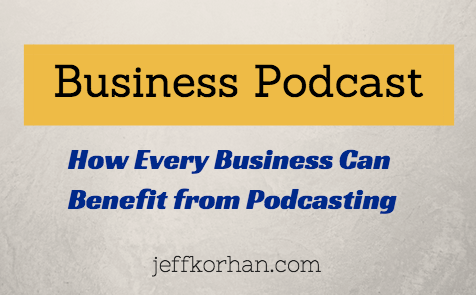Podcast: Play in new window | Download
Subscribe: RSS
This is Episode 23 of This Old New Business weekly business podcast with Jeff Korhan.
 In this episode we dive into why every business should be podcasting – and how to get started. My journey with podcasting started long before our launch on July 26th, 2014.
In this episode we dive into why every business should be podcasting – and how to get started. My journey with podcasting started long before our launch on July 26th, 2014.
Many of my friends said: You have to start podcasting! After 23 episodes I now understand their enthusiasm. If anything, I would say they undersold the benefits of starting a business podcast.
Note: There are some affiliate links associated with the recommended resources in these notes, but only for products and services that I personally use and pay for myself. That’s why I recommend them.
Podcasting is the New Talk Radio
It’s helpful to think of podcasting as the new talk radio – because it is. Just a few days ago I was listening to a traditional radio station in my car and the host suggested downloading their app for listening on a smartphone.
That alone should tell you that the proliferation of mobile devices is behind the explosive growth of podcasting.
Just like so many other forms of media, reaching an audience used to require hefty budgets for equipment; but no more. You only need a computer and microphone to record with free software, and a low-cost hosting service (there are many) that syndicates your content to iTunes and other channels, including your own website.
In the next episode we tackle the technology. For now, let’s take a look at 5 benefits of a business podcast that will get you inspired.
#1 – Share Your Unique Perspective
The goal of marketing is be memorable, and that is naturally accomplished by sharing your voice on topics relevant to your business audience.
Your perspective and that of the people within your organization is a differentiator that personalizes the business, thereby making it more likeable.
#2 – Learn from Experts and Like-Minded Professionals
You are in an enviable position as a podcast host, because people want to tell their story. They are eager to reach and help your audience, and when encouraged to share, your show will help their audience in return.
Your podcast interviews give you the opportunity to meet and learn from influential people. Plus, you’ll learn how to be a better listener and conversationalist.
#3 – Build a Sustainable Audience
Podcasts help to build sustainable audiences because the audio content tends to naturally build familiarity and intimate relationships. Listeners tend to subscribe and regularly listen to each episode, often more than once.
As long as your show continues to deliver valuable content, it will earn the trust of listeners that is vital for them to invest in your products and services.
#4 – Audio is Easy to Create and Consume
It takes time to create quality content for a blog. However, with a little organization and a few good ideas you can create interesting and useful audio content. That’s the creation benefit.
In terms of consumption, people tend to listen to podcasts when they are commuting or exercising. These are times when you have their full attention, which is seldom possible with a blog or even a YouTube video.
#5 – Technology is Affordable and Easy to Learn
We’ll cover technology in detail in the upcoming episode. For now, check out some of the resources in the KeyTakeAways below.
The key to learning the technology for podcasting is a structured, step-by-step approach that is coupled with a reliable support system.
Is your business ready for podcasting? Listen to the audio to learn more.
Lighting Round Tips and Advice
Jeff’s Sales or Marketing Advice – Make lists of whatever requires your focus, such as prospective buyers, key influencers, or social media channels that need more attention. You can use Checkvist to organize your lists.
One of My Favorite Productivity Tips – Trello is a flexible workflow management tool that helps you organize projects into lists and tasks according to their place in the workflow.
A Quote that has Inspired Jeff’s Success – “To give anything less than your best is to sacrifice the gift.” Steve Prefontaine.
Key Take-Aways
- Learn more about podcasting from Pat Flynn’s podcasting tutorial.
- For one US Dollar, you can buy the Podcast Launch eBook by John Lee Dumas on Amazon
- Cliff Ravenscraft offers the Podcasting A to Z course at Podcast Answerman.
- Podasters’ Paradise, also by John Lee Dumas, is the podscasters member community that I chose to learn podasting, and that I still derive benefit from. Check out the free webinars to learn if its right for you.
How to subscribe to This Old New Business podcast
Click here to subscribe via iTunes.
You can also subscribe via Stitcher.
Help us Spread the Word
Let your Twitter followers know about this podcast with this ready-made tweet.
If you enjoyed this episode of This Old New Marketing podcast, please head over to iTunes or Stitcher to leave a rating, write a review, or subscribe.
About the Author: Jeff Korhan, MBA, is the author of Built-In Social: Essential Social Marketing Practices for Every Small Business and host of This Old New Business podcast.
He helps mainstream businesses adapt their traditional growth practices to a digital world. Connect with Jeff on LinkedIn, Twitter, Facebook, and Google+



